Use of Instagram as an Educational Strategy for Learning Animal Reproduction
Simple Summary
Abstract
1. Introduction
2. Materials and Methods
2.1. Study Background
2.2. Instagram Use and Survey Preparation
2.3. Data Analysis
3. Results
3.1. Instagram Metrics
3.2. Survey Analysis
4. Discussion
5. Conclusions
Supplementary Materials
Funding
Institutional Review Board Statement
Informed Consent Statement
Data Availability Statement
Conflicts of Interest
References
- Lahuerta-Otero, E.; Cordero-Gutiérrez, R.; Izquierdo-Álvarez, V. Using social media to enhance learning and motivate students in the higher education classroom. In Learning Technology for Education Challenges; Uden, L., Liberona, D., Sanchez, G., Rodríguez-González, S., Eds.; Communications in Computer and Information Science; Springer: Cham, Switzerland, 2019; Volume 1011, pp. 351–361. [Google Scholar] [CrossRef]
- Cendrero, N.; Valverde, J. Social media in Higher Education: Systematic review of the literature (2018–2023). Int. J. Educ. Res. Innov. 2024, 21, 1–12. [Google Scholar] [CrossRef]
- Zhang, J.; Huang, Y.; Wu, F.; Kan, W.; Zhu, X. Scaling up online professional development through institution-iniated blended learning programs in higher education. Internet High Educ. 2025, 65, 100988. [Google Scholar] [CrossRef]
- Woodcock, B.; Middleton, A.; Nortcliffe, A. Considering the smartphone learner: Developing innovation to investigate the opportunities for students and their interest. Stud. Engagem. Exp. J. 2012, 1, 1–15. [Google Scholar] [CrossRef]
- Howard, J. How Many People Own Smartphones (2023–2038). 2023. Exploding Topics. Available online: https://explodingtopics.com/blog/smartphone-stats (accessed on 4 December 2024).
- Vázquez-Cano, E. Mobile distance learning with smartphones and Apps in higher education. Educ. Sci. Theory Pract. 2014, 14, 1505–1520. [Google Scholar] [CrossRef][Green Version]
- Loredo e Silva, M.P.; Souza Matos, B.D.; Ezequiel, O.S.; Granero Lucchetti, A.L.; Lucchetti, G. The use of smartphones in different phases of medical school and its relationship to internet addiction and learning approaches. J. Med. Syst. 2018, 42, 106. [Google Scholar] [CrossRef]
- Rozgonjuk, D.; Saal, K.; Täht, K. Problematic smartphone use, deep and surface approaches to learning, and social media use in lectures. Int. J. Environ. Res. Public Health 2018, 15, 92. [Google Scholar] [CrossRef]
- Muca, E.; Cavallini, D.; Odore, R.; Baratta, M.; Bergero, D.; Valle, E. Are veterinary students using technologies and online learning resources for didactic training? A mini-meta analysis. Educ. Sci. 2022, 12, 573. [Google Scholar] [CrossRef]
- Amjad, A.I.; Aslam, S.; Tabassum, U.; Sial, Z.A.; Shafgat, F. Digital equity and accessibility in higher education: Reaching the unreached. Eur. J. Educ. 2024, 59, e12795. [Google Scholar] [CrossRef]
- Jisc. Student Digital Experience Insights Survey 2023/24. UK Higher Education (HE) Survey Findings. Available online: https://repository.jisc.ac.uk/9646/1/DEI-2024-student-he-report.pdf (accessed on 9 July 2025).
- Gledhill, L.; Dale, V.H.M.; Powney, S.; Gaitskell-Phillips, G.H.L.; Short, N.R.M. An international survey of veterinary students to assess their use of online learning resources. J. Vet. Med. Educ. 2017, 44, 692–703. [Google Scholar] [CrossRef]
- Campbell, L.O.; Cox, T.D. Digital video as a personalized learning assignment: A qualitative study of student authored video using the ICSDR model. J. Scholarsh. Teach. Learn. 2018, 18, 11–24. [Google Scholar] [CrossRef]
- Abbott, D.; Roberts, A.; Maclsaac, D.; Flaconer, K.; Genz, F.; Hoffmann, S.; Bresges, A.; Weber, J. Adding student video projects to physical courses. Phys. Teach. 2019, 57, 224. [Google Scholar] [CrossRef]
- Dixon, S.J. Social Media—Statistics & Facts. 2023. Available online: https://www.statista.com/topics/1164/social-networks/#topicOverview. (accessed on 20 April 2025).
- Dixon, S.J. Global Social Networks Ranked by Number of Users 2023. 2023. Available online: https://www.statista.com/statistics/272014/global-social-networks-ranked-by-number-of-users/ (accessed on 20 April 2025).
- Erarslam, A. Instagram as an education platform for EFL learners. J. Educ. Technol.-TOJET 2019, 18, 54–69. [Google Scholar]
- Navandar, A.; Frías López, D.; Alejo, L.B. The use of Instagram in the sports biomechanics classroom. Front. Psychol. 2021, 12, 711779. [Google Scholar] [CrossRef]
- León-Gómez, A.; Calderón-Garrido, D.; Gil-Fernández, R. The use of social networks in a virtual University. Campus Virtuales 2019, 8, 100–109. [Google Scholar]
- Alonso López, N.; Terol Bolinches, R. Transmedia literacy and social networks: Case study of Instagram as a teaching instrument in university classrooms. Rev. Comun. Tecnol. Emerg. 2020, 18, 138–160. [Google Scholar] [CrossRef]
- Ruiz San-Miguel, F.J.; Ruiz-Gómez, L.A.; Hinojosa Becerra, M.; Maldonado-Espinosa, M. Use of Instagram as a Tool for Debate and Learning. In Proceedings of the 15th Iberian Conference on Information Systems and Technologies (CISTI), Seville, Spain, 24–27 June 2020. [Google Scholar]
- Carpenter, J.P.; Morrison, S.A.; Craft, M.; Lee, M. How and why are educators using Instagram? Teach. Teach. Educ. 2020, 96, 103149. [Google Scholar] [CrossRef]
- Punie, Y.; Redecker, C. European Framework for the Digital Competence of Educators: DigCompEdu; EUR 28775 EN.; Publications Office of the European Union: Luxembourg, 2017. [Google Scholar]
- Cabero-Almenara, J.; Gutiérrez-Castillo, J.J.; Palacios-Rodríguez, A.; Barroso-Osuna, J. Development of the teacher digital competence validation of DigCompEdu check-in questionnaire in the university context of Andalusia (Spain). Sustainability 2020, 12, 6094. [Google Scholar] [CrossRef]
- Hayman, R.; Smith, E.E. Social media in undergraduate teaching and learning: A scoping review protocol. PLoS ONE 2023, 18, e0291306. [Google Scholar] [CrossRef] [PubMed] [PubMed Central]
- Eurell, J.A.C.; Diamond, N.A.; Buie, B.; Grant, D.; Pijanowski, G.J. Tablet computers in the Veterinary curriculum. J. Vet. Med. Educ. 2005, 32, 113–116. [Google Scholar] [CrossRef]
- Wang, H.; Rush, B.R.; Wilkerson, M.; van der Merwe, D. Exploring the use of tablet PCs in veterinary medical education: Opportunity or obstacle? J. Vet. Med. Educ. 2014, 41, 122–131. [Google Scholar] [CrossRef]
- Voss, C.; Shorter, P.; Mueller-Coyne, J.; Turner, K. Screen time, phone usage, and social media usage: Before and during the COVID-19 pandemic. Digit. Health 2023, 9, 20552076231171510. [Google Scholar] [CrossRef]
- Hsieh, B. Making and missing connections: Exploring twitter chats as a learning tool in a preservice teacher education course. Contemp. Issues Technol. Teach. Educ. 2017, 17, 549–568. [Google Scholar]
- Tiellet, C.A.B.; Pereira, A.G.; Reategui, E.B.; Lima, J.V.; Chambel, T. Design and evaluation of a hypervideo environment to support veterinary surgery learning. In Proceedings of the 21st ACM Conference on Hypertext and Hypermedia, Toronto, ON, Canada, 13–16 June 2010; pp. 213–222. [Google Scholar]
- Roshier, A.L.; Foster, N.; Jones, M.A. Veterinary students’ usage and perception of video teaching resources. BMC Med. Educ. 2011, 11, 1. [Google Scholar] [CrossRef]
- Müller, L.R.; Tipold, A.; Ehlers, J.P.; Schaper, E. TiHoVideos: Veterinary students’ utilization of instructional videos on clinical skills. BMC Vet. Res. 2019, 15, 326. [Google Scholar] [CrossRef]
- Jeon, S.C.; Kim, J.H.; Kim, S.J.; Kwon, H.J.; Choi, Y.J.; Jung, K.; Park, M.I.; Park, S.J. Effect of sending educational video clips via smartphone mobile messenger on bowel preparation before colonoscopy. Clin. Endosc. 2019, 52, 53–58. [Google Scholar] [CrossRef]
- Taylor, A.D.; Hung, W. The effects of microlearning: A scoping review. Educ. Technol. Res. Dev. 2022, 70, 363–395. [Google Scholar] [CrossRef]
- Findyartini, A.; Greviana, N.; Hanum, C.; Wiyarta, E.; Novarianto, J.K.; Nugroho Supranoto, Y.T.; Rafa Ayusha, M.A.; Oktaria, D.; Sueningrum, A.S.; Pratiwi, Y.S.; et al. “How is social media used for learning?”: Relationships between social media use by medical students with their self-regulated learning skills. BMC Med. Educ. 2024, 24, 235. [Google Scholar] [CrossRef] [PubMed]
- Whiting, M.; Kinnison, T.; Mossop, L. Teaching Tip: Developing an intercollegiate twitter forum to improve student exam study and digital professionalism. J. Vet. Med. Educ. 2016, 43, 282–286. [Google Scholar] [CrossRef] [PubMed]
- Kinnison, T.; Whiting, M.; Magnier, K.; Mossop, L. Evaluating #VetFinals: Can twitter help students prepare for final examinations? Med. Teach. 2017, 39, 436–443. [Google Scholar] [PubMed]
- Saadeh, K.; Henderson, V.; Julita Paramasivam, S.; Jeevaratnam, K. Use of online resources to study cardiology by clinical veterinary students in the United Kingdom. J. Vet. Med. Educ. 2022, 49, 223–235. [Google Scholar] [CrossRef]
- Root Kustritz, M.V. Use of Facebook as a teaching tool in a veterinary communications course. J. Vet. Med. Educ. 2013, 40, 327–332. [Google Scholar] [CrossRef] [PubMed]
- Ober, C. Twitter in the veterinary diagnostic imaging classroom: Examination outcomes and student views. J. Vet. Med. Educ. 2019, 46, 91–96. [Google Scholar] [CrossRef]
- Lamanna, M.; Muca, E.; Buonaiuto, G.; Formigoni, A.; Cavallini, D. From posts to practice: Instagram’s role in veterinary dairy cow nutrition education-How does the audience interact and apply knowledge? A survey study. J. Dairy Sci. 2025, 108, 1659–1671. [Google Scholar] [CrossRef]
- Pérez-Juarez, M.A.; González-Ortega, D.; Aguilar-Pérez, J.M. Digital distractions from the point of view of higher education students. Sustainability 2023, 15, 6044. [Google Scholar] [CrossRef]
- Zhang, W. From distraction to dedication: The paradoxical effects of social media on student academic performance. Pak. J. life Soc. Sci. 2024, 22, 8622–8634. [Google Scholar] [CrossRef]
- Al-Rahmi, W.M.; Othman, M.S.; Musa, M.A. The improvement of students’ academic performance by using social media through collaborative learning in Malaysian higher education. Asian Soc. Sci. 2014, 10, 210–221. [Google Scholar] [CrossRef]
- Kivunja, C. Innovative methodologies for 21st century learning, teaching and assessment: A convenience sampling investigation into the use of social media technologies in higher education. Int. J. High. Educ. 2015, 4, 1–26. [Google Scholar] [CrossRef][Green Version]
- Ansari, J.A.N.; Khan, N.A. Exploring the role of social media in collaborative learning the new domain of learning. Smart Learn. Environ. 2020, 7, 9. [Google Scholar] [CrossRef]
- González, C. The relationship between approaches to teaching, approaches to e-teaching and perceptions of the teaching situation in relation to e-learning among higher education teachers. Instr. Sci. 2012, 40, 975–998. [Google Scholar] [CrossRef]
- Gardner, H.; Hatch, T. Educational implications of the theory of multiple intelligences. Educ. Res. 1989, 18, 4–10. [Google Scholar] [CrossRef]
- Delcambre, J.; Allsop, S. Educational alternatives for Veterinary Anatomy Teaching. In AAVMC Use of Animals in Veterinary Education Handbook; Hunt, J., Delcambre, J., Baillie, S., Eds.; American Association of Veterinary Medical Colleges: Washington, DC, USA, 2024; pp. 12–16. [Google Scholar]
- Baillie, S.; Kinnison, T.; Forrest, N.; Dale, V.H.M.; Ehlers, J.P.; Koch, M.; M’andoki, M.; Ciobotaru, E.; e Groot, E.; Boerboom, T.B.B.; et al. Developing an online professional network for veterinary education: The NOVIVE project. J. Vet. Med. Educ. 2011, 38, 395–403. [Google Scholar] [CrossRef] [PubMed]
- WikiVet Educational Foundation. WikiVet [Internet]. Available online: https://en.wikivet.net/Veterinary_Education_Online (accessed on 10 June 2016).
- Fass-Holmes, B. Survey fatigue-what is it role in undergraduates’ survey participation and response rates? J. Interdiscip. Stud. Educ. 2022, 11, 102–125. [Google Scholar]
- Bethlehem, J. Selection bias in web surveys. Int. Stat. Rev. 2010, 78, 161–188. [Google Scholar] [CrossRef]
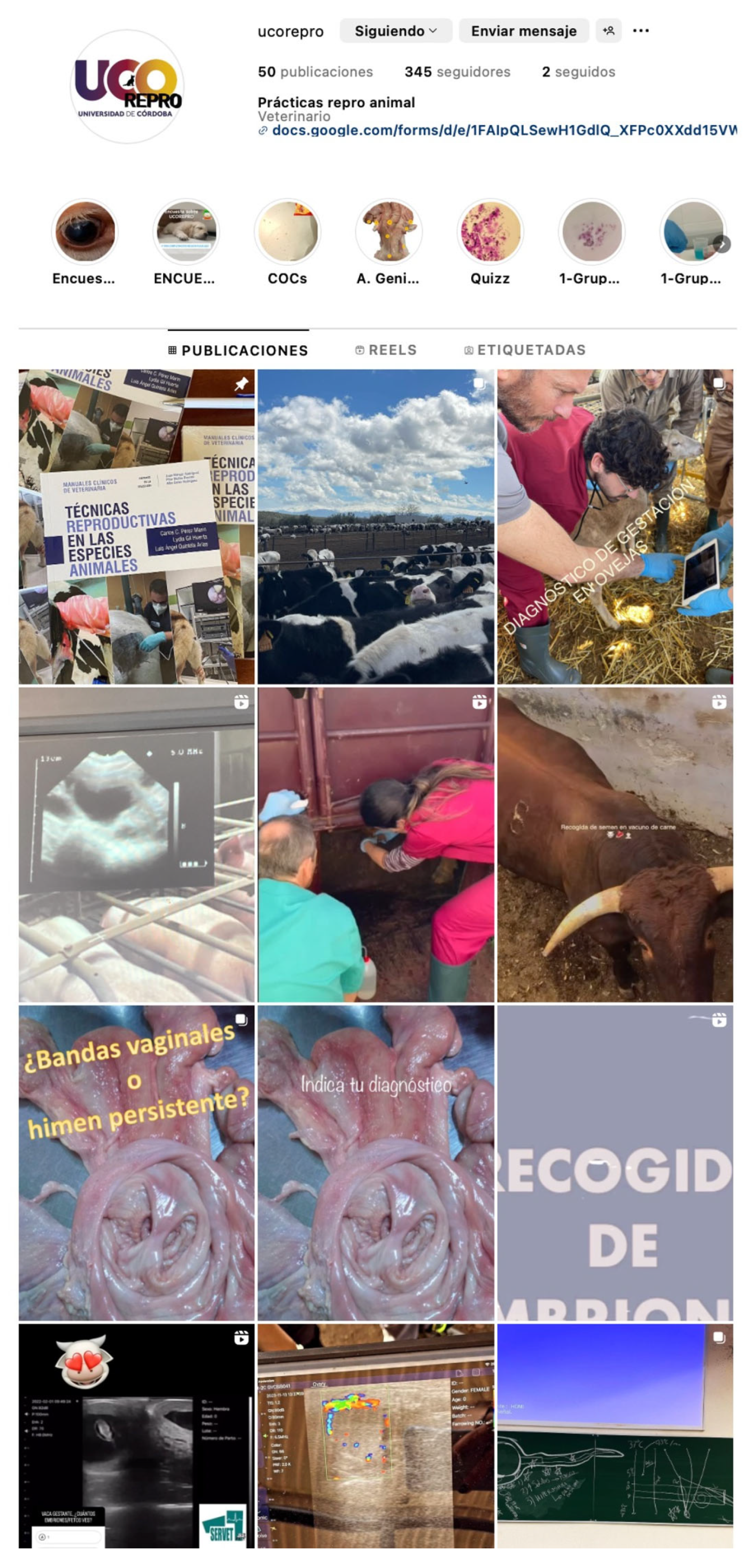
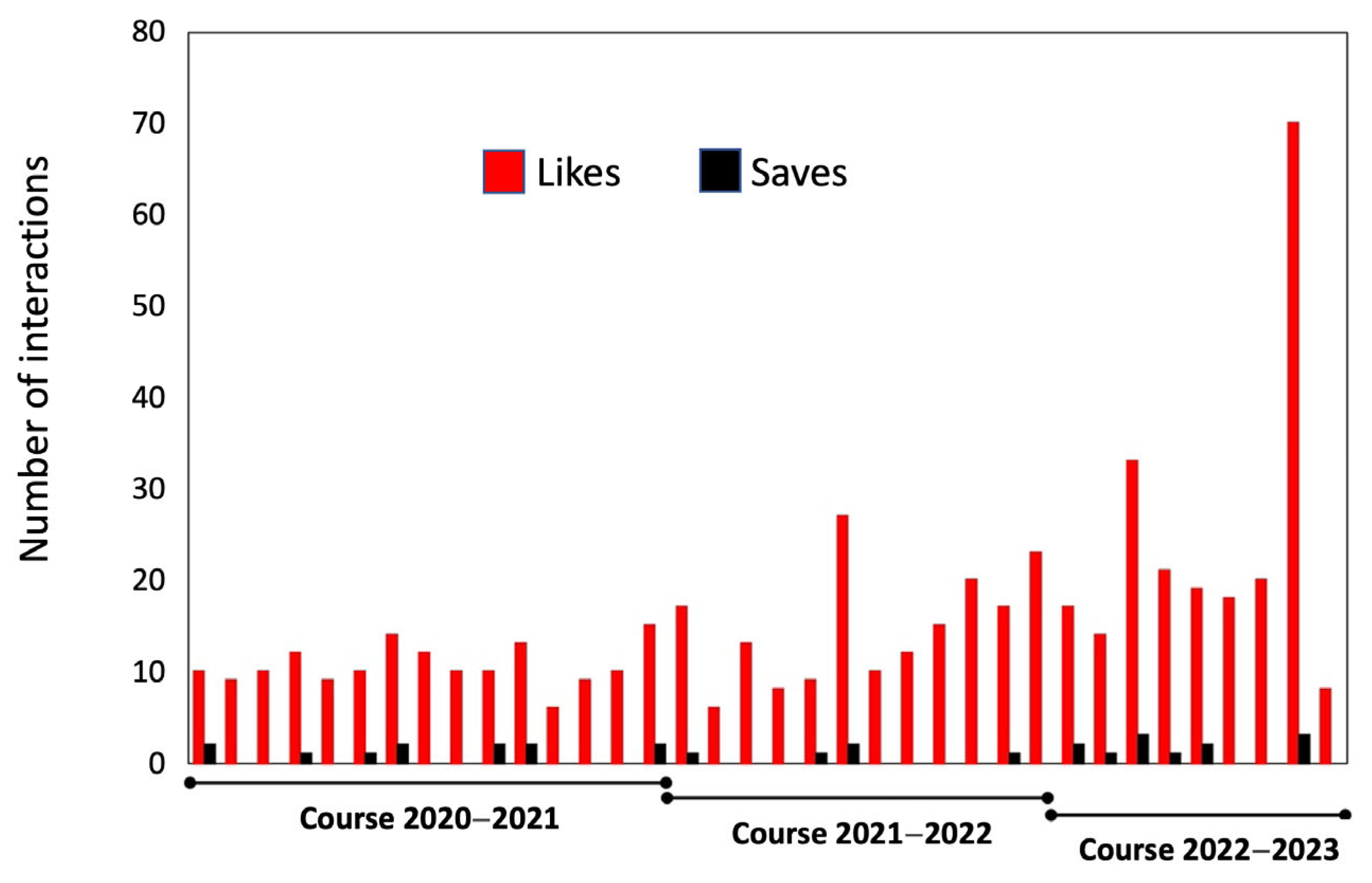
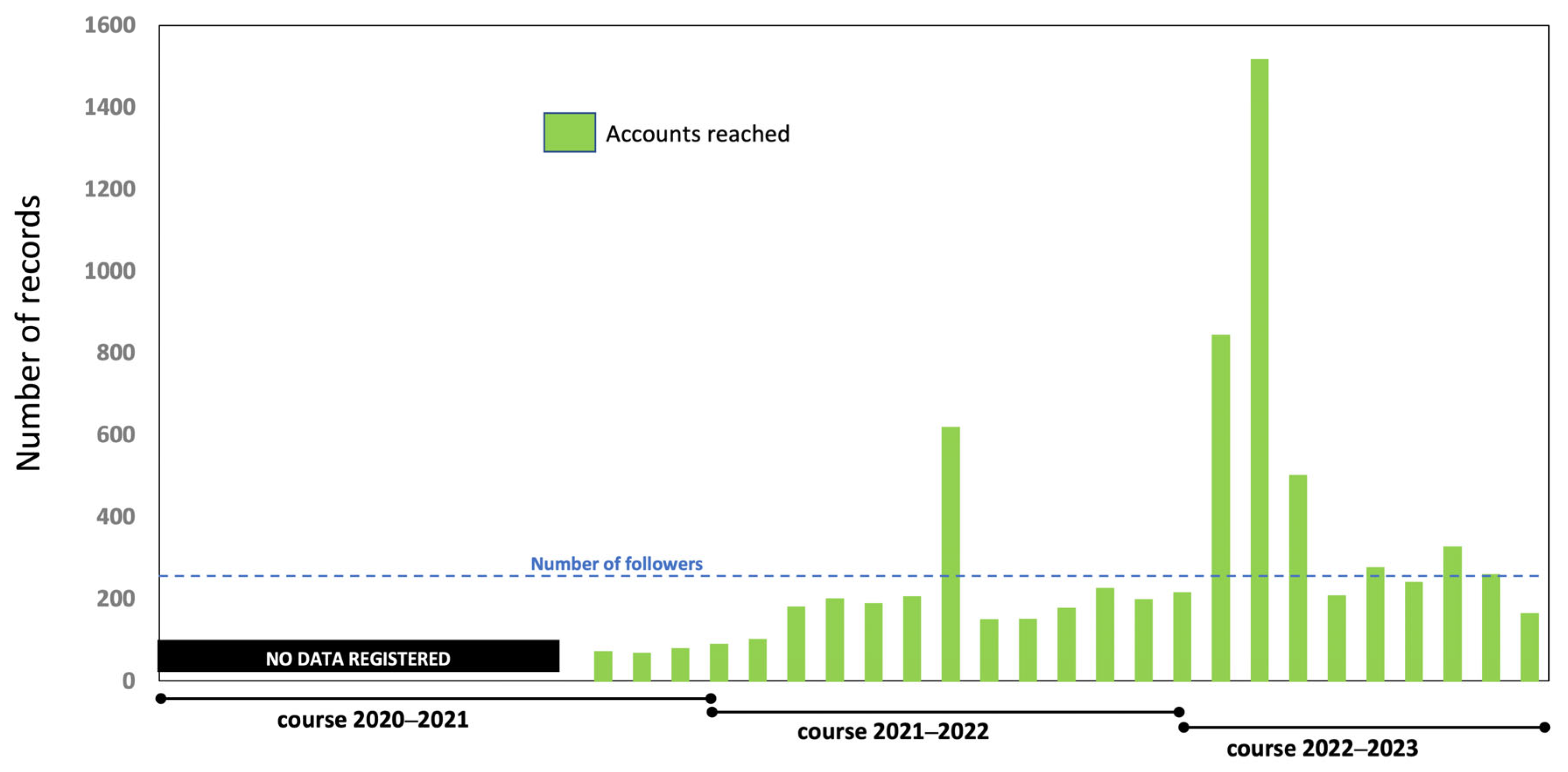
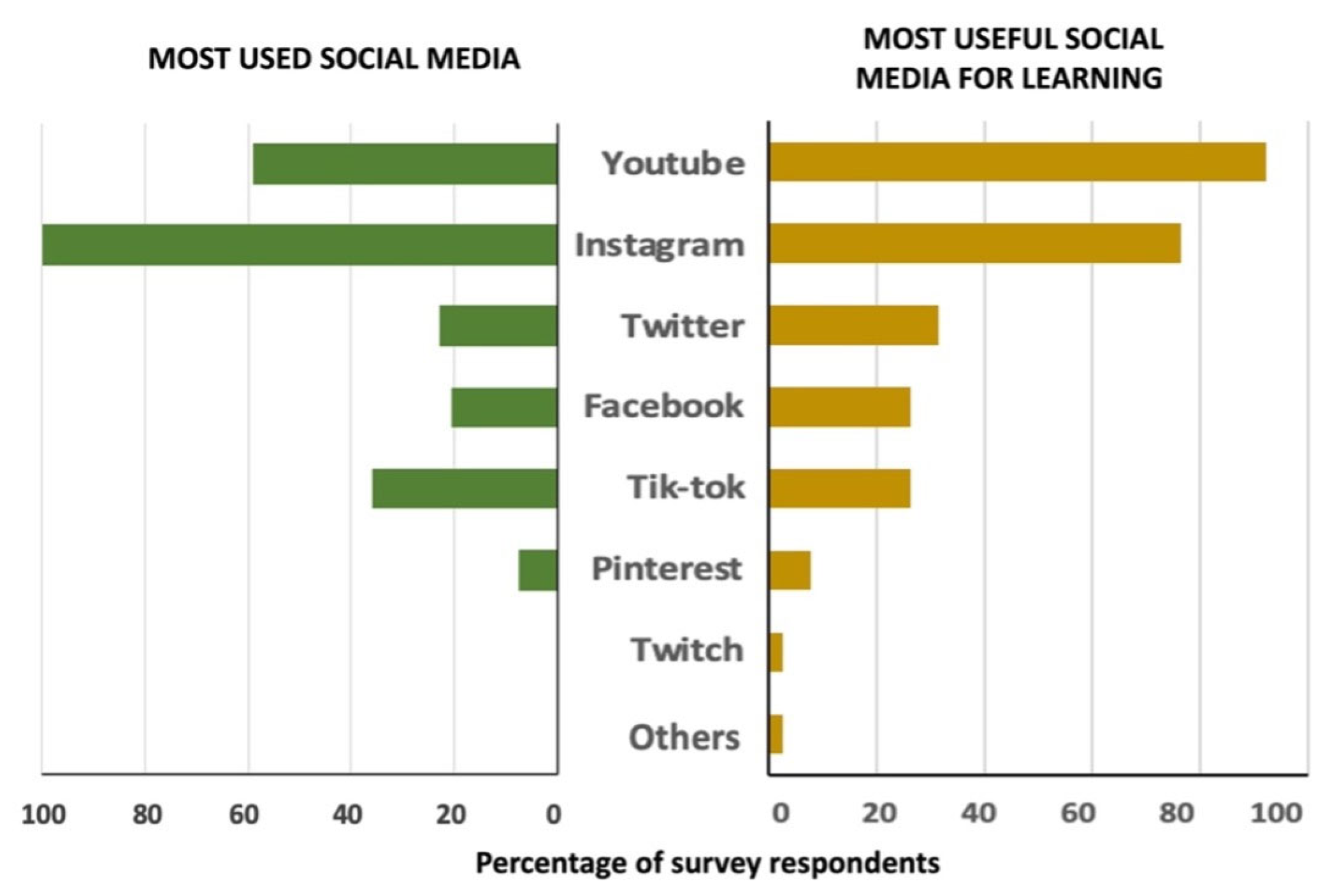
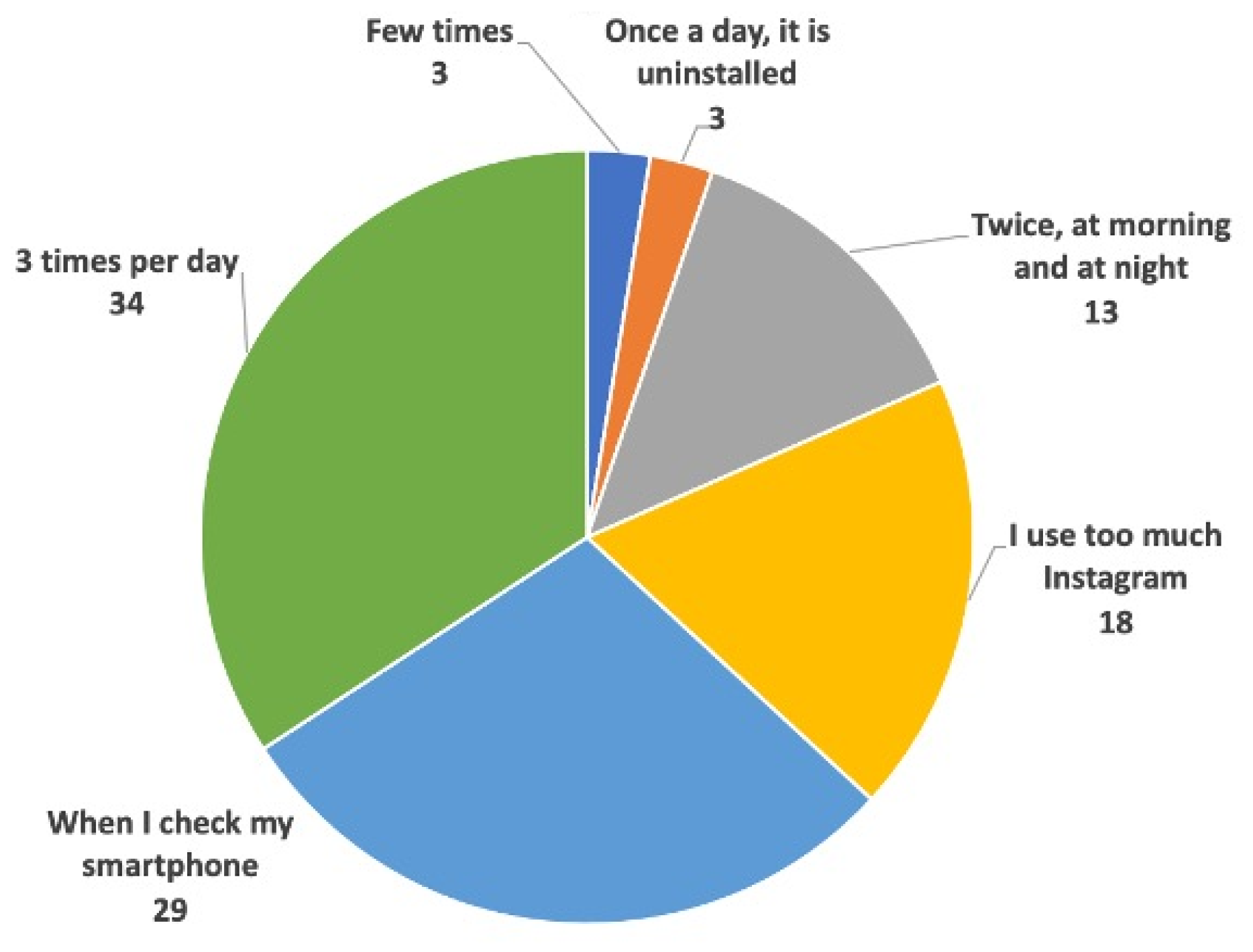
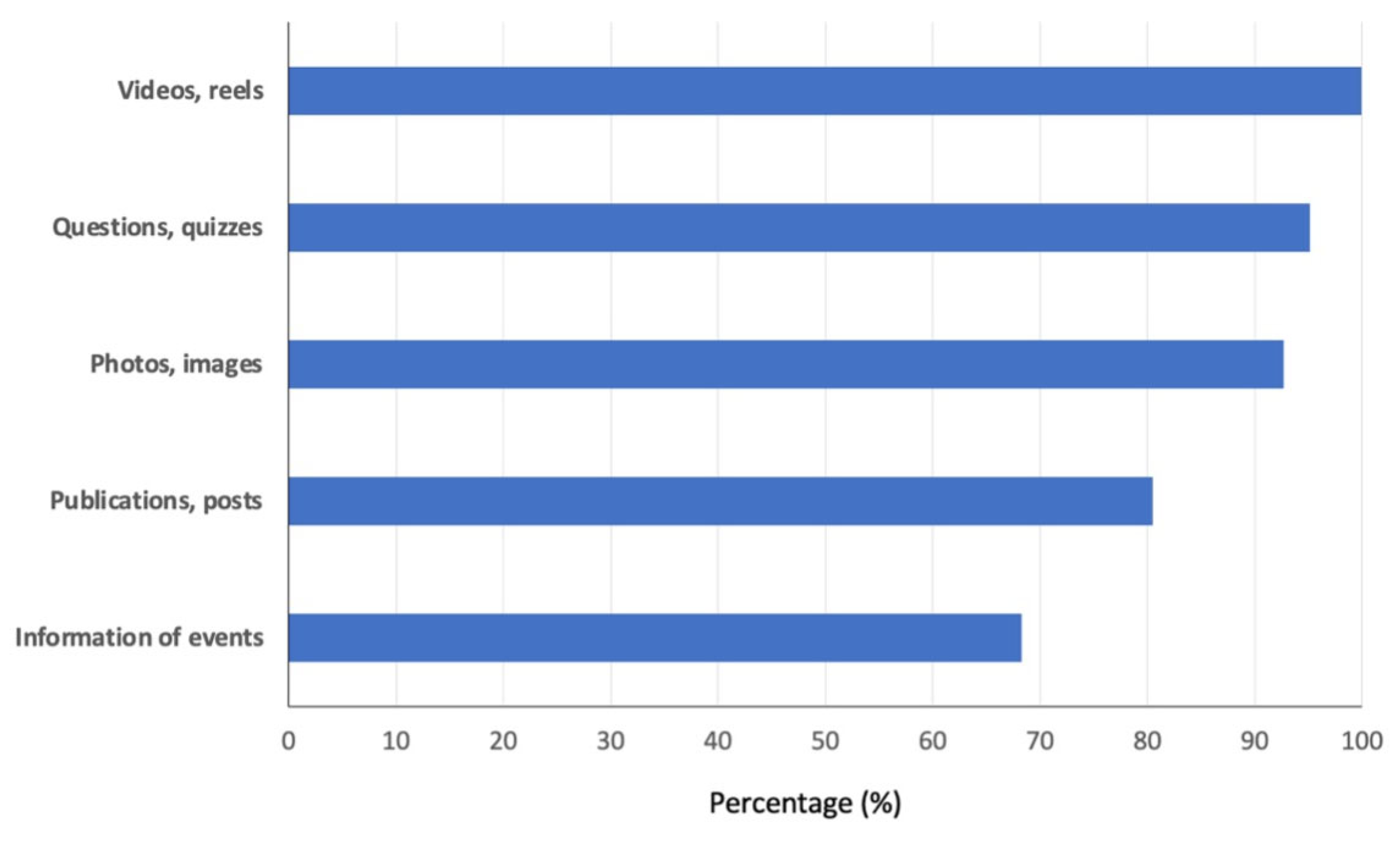

| Student | Opinions |
|---|---|
| 1 | “I think it would be very interesting to announce in advance when the contents will be uploaded, since they often get lost on Instagram.” |
| 2 | “Higher dissemination and impact of this account could attract more student attention.” |
| 3 | “I really like this initiative because it encourages using social media for learning. Therefore, I believe more content should be posted, as it motivates followers to participate and become interested in these topics.” |
| 4 | “I really liked knowing that some professors make an effort to connect with students, trying to use new tools for them. But social media (like Instagram) has many disadvantages. And there are already many of us spending too much time on our phones (several hours a day). I’m not sure if further promoting the use of these platforms (which can bring many problems to young people), even for an academic activity, is a good idea. Furthermore, some people don’t want to use social media too much. But in general, the idea seems very healthy for Instagram users, and those who like to use social media to learn things…”. |
| 5 | “I consider it a very good initiative with great untapped potential. As a student, I believe that many times we don’t interact with this type of account because we are afraid of saying some crazy or wrong idea.” |
| 6 | “It would be useful to post more frequently and on different topics, in order to help students with the subject.” |
| 7 | “In my opinion, it fosters a lot of interest in the subject and contributes to a better understanding of the classes and the contents. It could offer educational advantages for students, and it is a new, more fun, entertaining and participatory way to acquire knowledge about the subject.” |
| 8 | “I think teachers should invest in this kind of activity because, amid all the useless content, we can find interesting and useful information while we are taking breaks, which captures our attention.” |
| 9 | “It’s a very visual, schematic and attractive tool for students. If real clinical cases or very simple explanations are shared this way, it can make a big difference to reinforcing concepts and training material…” |
| 10 | “I think it’s great that teachers are so involved and make an effort for us to learn in such an engaging and dynamic way. And using Instagram for this purpose is innovative and original. I hope there are more subjects like this.” |
| 11 | “It’s a good initiative, but we tend to forget it exists, or we are not so used to using social media (in this case, Instagram) for academic purposes. But it’s very interesting, and in my opinion, we should participate more in UCOREPRO.” |
Disclaimer/Publisher’s Note: The statements, opinions and data contained in all publications are solely those of the individual author(s) and contributor(s) and not of MDPI and/or the editor(s). MDPI and/or the editor(s) disclaim responsibility for any injury to people or property resulting from any ideas, methods, instructions or products referred to in the content. |
© 2025 by the author. Licensee MDPI, Basel, Switzerland. This article is an open access article distributed under the terms and conditions of the Creative Commons Attribution (CC BY) license (https://creativecommons.org/licenses/by/4.0/).
Share and Cite
Pérez-Marín, C.C. Use of Instagram as an Educational Strategy for Learning Animal Reproduction. Vet. Sci. 2025, 12, 698. https://doi.org/10.3390/vetsci12080698
Pérez-Marín CC. Use of Instagram as an Educational Strategy for Learning Animal Reproduction. Veterinary Sciences. 2025; 12(8):698. https://doi.org/10.3390/vetsci12080698
Chicago/Turabian StylePérez-Marín, Carlos C. 2025. "Use of Instagram as an Educational Strategy for Learning Animal Reproduction" Veterinary Sciences 12, no. 8: 698. https://doi.org/10.3390/vetsci12080698
APA StylePérez-Marín, C. C. (2025). Use of Instagram as an Educational Strategy for Learning Animal Reproduction. Veterinary Sciences, 12(8), 698. https://doi.org/10.3390/vetsci12080698






